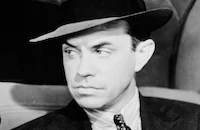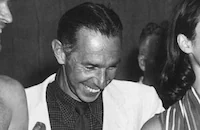The Saint in Palm Springs

Brief Synopsis
Cast & Crew
Jack Hively
George Sanders
Wendy Barrie
Paul Guilfoyle
Jonathan Hale
Linda Hayes
Film Details
Technical Specs

Synopsis
Simon Templar, the debonair sleuth known as "The Saint," becomes involved in murder when his friend, New York City police inspector Henry Fernack, asks him to act as bodyguard for Peter Johnson, the brother of an old friend who is carrying three rare stamps valued at $200,000. Johnson has smuggled the stamps, which represent his brother's life savings, out of Europe to present to his niece, Elna Johnson, a tennis pro at a resort in Palm Springs, California. Simon agrees to accompany Fernack's friend to Palm Springs, but as Peter withdraws the stamps from his hotel room safe, a gunshot shot rings out and he falls to the ground, dead. Simon strikes Peter's assailant in the face with his "Saint" ring, but the man escapes, leaving the stamps behind. Simon then boards the train to Palm Springs, where he meets Margaret Forbes, a fellow passenger who is also bound for the Twin Palms Lodge in Palm Springs. At the lodge, Simon meets his old friend, pickpocket Clarence "Pearly" Gates, who is working as the house detective while on probation from prison. When Simon is assaulted in his bungalow by a thief in search of the stamps, he informs Pearly that he has been followed from New York and asks for his help. The next day, Pearly introduces Simon to Elna, but when he presents her with the locket in which the stamps have been hidden, she discovers that the locket is empty. Simon asks Elna for twenty-four hours to find the stamps, and after obtaining a list of the hotel guests who had checked in the previous day, he asks Pearly to pick their pockets, hoping to find the stamps. As they examine their lot, Simon finds the stamps in a pillbox containing knock-out pills. When Pearly is unable to remember from whose pocket he procured the pillbox, Simon asks police chief R. L. Graves to help set a trap for the murderer. That night, the pickpocket victims are summoned to a room to reclaim their losses, but before the owner of the pillbox can be identified, a police officer is murdered and the box disappears. Soon after, an armed man reclaims the box from Simon, but the sleuth had already removed the stamps from the box. The next morning, Simon presents the stamps to Elna, who locks them in the hotel safe. That afternoon, Elna, Simon and Margaret go horseback riding and Simon advises Elna that the stamps would be safer in her possession. When she returns to the lodge, Elna withdraws the stamps from the safe, and that night, Pearly and Simon watch her bungalow in hopes of trapping the murderer. When Elna returns to her bungalow, Margaret demands the stamps at gunpoint, but after Margaret runs outside, a shot rings out and she falls to the ground, dead. Simon then shows Elna a telegram that he had received from Fernack, informing him that Margaret was a foreign agent in search of the stamps. Margaret's death leads Simon to conclude that they are now dealing with an organized gang, and he sets another trap for the murderer by sending a note to Elna instructing her to meet him at the Joshua tree at midnight. The murderer intercepts the note, and that night, as Pearly and Elna wait for Simon, Mr. Evans, a guest at the hotel, invites Simon for a drink and drugs him with knock-out pills. Failing to find the stamps in Simon's possession, Evans orders one of his men to guard Simon while he and the rest of the gang drive to the Joshua tree. At the tree, as Evans threatens Elna, Simon, who had substituted aspirin for the knock-out pills, rides up and tricks Evans into confessing to the murders. At that moment, Chief Graves and his men appear from the shadows, and when Simon reveals the scar that the blow from his ring inscribed upon Evans' face, the case is closed.

Director
Jack Hively
Cast

George Sanders

Wendy Barrie

Paul Guilfoyle

Jonathan Hale

Linda Hayes
Ferris Taylor
Harry Shannon
Eddie Dunn
Gene Rizzi
Joey Ray

Jack Arnold

Robert Carson
Richard Crane
Chester Tallman
Gayle Mellott
Arthur Loft
James Harrison
Frank O'connor
Norman Mayes
Edmund Elton
Charles Quigley
Terry Belmont
Henry Roquemore
Chick Collins
Ed Thomas
Peter Lynn

Mary Maclaren
Betty Farrington
Crew
Howard Benedict
Jerry Cady
Leslie Charteris
Carroll Clark
William Dorfman
George Hively
Lee Marcus
Van Nest Polglase
Renie
Richard Van Hessen
Vernon L. Walker
Roy Webb
Harry Wild

Film Details
Technical Specs

Articles
The Saint in Palm Springs
Based on the stories of Leslie Charteris, The Saint film series was comprised of quickly made "B" pictures featuring the charming and mysterious detective Simon Templar, aka The Saint . Described by Charteris, Templar was "a roaming adventurer who loves a fight...a dashing daredevil, imperturbable, debonair, preposterously handsome, a pirate or a philanthropist, as the occasion demands. He lives for the pursuit of excitement, for the one triumphant moment that is his alone."
The usual suspects were on board for this film producer Howard Benedict, director Jack Hively, Sanders as Templar, Wendy Barrie as the love interest and Paul Guilfoyle as Templar's sidekick Pearly Gates, who had appeared in the previous Saint film, The Saint Takes Over (1940). For The Saint in Palm Springs, which was shot from October November 11, 1940, Charteris himself suggested the story line the Saint is asked to guard a man going to Palm Springs with $200,000 worth of rare stamps. Of course a murder takes place and Templar has to find the killer. Little of Charteris' original idea was used, so he recycled it later into another Saint novel, The Saint Goes West which was very critical of Hollywood.
After six films (including the first, The Saint in New York (1938), starring Louis Hayward), the franchise was becoming stale. Variety admitted, "The Saint needs better and fresher story material than provided here or he will be a forgotten man with film audiences in the secondary houses. Picture is slow and tedious in its unwinding, filled with stereotyped situations that are stock in trade for quickie whodunits [...] George Sanders and other members of the cast strive to overcome the mediocre story material and director Jack Hively is handed an impossible assignment." Bosley Crowther, in his New York Times review wrote that the writers seem to have sent Simon Templar on vacation. "The Saint has a most agreeable time playing tennis, riding horseback and kidding the girls while leisurely check-mating a desperate gang which is trying to snitch the philatelic gems. Since George Sanders is still the hero, it is a pleasure just to watch him have fun. But it isn't in the least entertaining to watch the sluggish plot unfold. If the familiar name of Director Jack Hively weren't prominent in the list of credits we'd suspect he'd taken a vacation, too. Obviously the scriptwriters did. For the benefit of those who keep records: the total number of murders this time is three."
Charteris was finally fed up with what he felt was the studio's miscasting of Simon Templar, and "even more than the casting, I objected to RKO's treatment of character and story lines. Here, of course, I was fighting the well-known 'producer syndrome', which automatically makes any film executive a genius who knows how much better a character could be portrayed and a plot developed than the stupid original creator." Charteris was so angered, he threatened to produce the films himself, but it never happened. RKO needed to spend money that was frozen in wartime England, so they moved production there, with Hugh Sinclair making two films as The Saint before the franchise ended in 1954 with The Saint's Return with Louis Hayward returning to the role.
If Charteris was fed up with RKO, the studio was fed up with him as well. Rather than deal with his complaints, they merely carried on with their own knock-off version, also starring George Sanders (and later, his older brother Tom Conway) as The Falcon.
Producer: Howard Benedict
Director: Jack Hively
Screenplay: Jerome Cady (writer); Leslie Charteris (story)
Cinematography: Harry Wild
Art Direction: Van Nest Polglase
Music: Roy Webb; Nathaniel Shilkret (uncredited)
Film Editing: George Hively
Cast: George Sanders (Simon Templar), Wendy Barrie (Elna Johnson), Paul Guilfoyle (Clarence "Pearly" Gates), Jonathan Hale (Inspector Henry Fernack), Linda Hayes (Margaret Forbes), Ferris Taylor (Mr. Evans).
BW-66m. Closed Captioning.
by Lorraine Lobianco
SOURCES:
Crowther, Bosley "The Screen: The Saint in Palm Springs" The New York Times 31 Jan 41
Pitts, Michael R. Famous Movie Detectives
"The Saint in Palm Springs" Variety 8 Jan 41
Tuska, Jon The Detective in Hollywood

The Saint in Palm Springs
Quotes
Trivia
Notes
Although the character played by Wendy Barrie is addressed as "Elna Johnson" in the dialogue, the Variety and New York Times reviews list her name as "Elna Massen". This was the fifth and final time that George Sanders played "Simon Templar," a role he took over from Louis Hayward in the 1939 RKO film The Saint Takes Over. It was also the last of "The Saint" series produced in the United States by RKO. The next film in the series, The Saint's Vacation (see below), was produced in England to utilize studio funds frozen by the British government during World War II and featured Hugh Sinclair in the title role. According to a February 1941 news item in Hollywood Reporter, the studio decided to cast Sanders as a new mystery character in a series to be developed by writers Lynn Root and Frank Fenton. The new character that was finally developed for Sanders was that of "Gay Lawrence, The Falcon," a role so similiar to "The Saint" that according to modern sources, Leslie Charteris, the creator of "The Saint," sued the studio for stealing his character. The first film in the series was The Gay Falcon, which featured Sanders and Wendy Barrie, his female lead in The Saint in Palm Springs and two other "Saint" films. For additional information about "The Saint," consult the Series Index and see entry for the 1938 film The Saint in New York in AFI Catalog of Feature Films, 1931-40; F3.3879.














